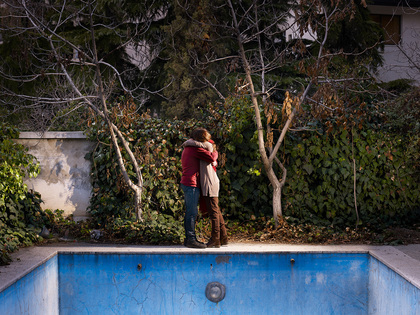-
From Current Issue
-
- Editor’s Letter Fire in the Heart
- Reviews I Gusti Ayu Kadek Murniasih
- Reviews 11th Seoul Mediacity Biennale: “One Escape at a Time”
- Dispatch Networked China
- One on One Monira Al Qadiri on Yukio Mishima
- Essays The rise of independent art spaces in pandemic-era Shanghai
- Features Tuan Andrew Nguyen
- Table of Contents
- Web Exclusives
- Archive
- Subscribe

R
E
V N
E
X
T
For the annual Rencontres de la Photographie in Arles, curators Anahita Ghabaian Etehadieh and Newsha Tavakolian brought together 66 Iranian photographers in a powerful and moving show in the historic French town’s Saint Anne Church, lifting the veil on Iran’s photography scene. The clock was set back 38 years to the Iranian Revolution of 1979, a moment in time when students in miniskirts protesting for freedom from monarchy were confronted with the establishment of a restrictive Islamic regime. This zero hour was the starting point for an ambitious show that guided visitors fluidly through photographs grouped under eight sequential themes, starting with “1979, Turmoil” and leading up to “The Environmental Crisis” of the contemporary era. (All section titles were translated by the author from French.)
As the Tehran-based gallerist Etehadieh (of Silk Road Gallery) and photographer Tavakolian explain in the accompanying catalog, photography prior to the revolution had been relegated to capturing the lifestyle of elites. During the revolution, the lens was turned toward everyone else at a time of dramatic change. Maryam Zandi showcases the expectant faces of thousands of intellectuals and activists standing in protest of the Pahlavi regime in January 1979. In a harrowing image by Kaveh Kazemi, a woman in a black hijab defiantly covers her face from the photographer’s view while brandishing an HKG3 rifle, loyal to the victorious Ayatollah Ruhollah Khomeini, who occupied the same university only weeks later. This pivotal moment in time was quickly overshadowed by the enduring Iran-Iraq War that lasted from 1980 to 1988, which brought us to the second theme of the show: “The Frontline in the Living Room.” Iranian photographers replaced foreign journalists in documenting wartime devastations, bringing traumatic images into people’s homes. Twenty years after the end of hostilities, a new generation of artists continues to reflect on this era. In the series “Nil Nil” (2008), Shadi Ghadirian juxtaposes feminine objects found in homes with weapons: a delicate table setting with a flowered china plate is accompanied by a bloody dagger, for example. A series of photographs by Saba Alizadeh, “Light and Soil” (2011), captures living room interiors with portraits of wounded soldiers projected onto couch surfaces.
This was also a time when Iranian society was compelled to abandon its attachment to a rich Persian heritage, in favor of a national identity based on Islam and defiance of the West. The show brings forward these tensions with two sections that match certainty with confusion: “What We Must Be,” followed by “Who Are We?” In the former, the omnipresence of religion is captured in photographs by Jalal Shams Azaran: loudspeakers dominate the cityscape in “Speakers” (2012), summoning people to participate in religious ceremonies. In “Who Are We?”, photographers such as Ghazaleh Hedayat, Jalal Sepehr and Ebrahim Noroozi raise tensions between Islam and Persian culture. The impact of religion on intimate lives is reflected in Babak Kazemi’s series, “The Exit of Shirin and Farhad” (2012), based on a famous, tragic love story. Wrapped in separate carpets, the sleeping figures of a man and a woman are captured lying next to each other, but restricted from achieving closer proximity.
With the re-election of the ultra-conservative Mahmoud Ahmadinejad in 2009, hundreds of thousands of voters took to the street to protest what was considered to be a fraudulent election. The country’s Green Movement was rapidly quashed by a repressive government, a tragic turn of events that was only compounded by the international sanctions that followed. Under the theme of “Torpor,” Alireza Fani presented delicate images of couples embracing in desolate spaces, while Mehrdad Naraghi showed images of abandoned rooms, as if to evoke a country placed under a spell of dormancy or slumber. Yet another section in the show, “Staging Reality,” showcased the artist duo Morteza Niknahad and Behnam Zakeri, who exhibited an image of Iranian men being boiled in cauldrons on a beach in “Public Space” (2015). In the same vein, 16 Azar 1332 (7 December 1953) from Azadeh Akhlaghi’s “By An Eye-Witness” series (2009–13) restaged the brutal killings of public figures.
“The Cinema Poet” section was the last stop in the presentation, presented at the heart of the exhibition space, honoring the rich heritage of Iranian visual poetry, such as in the photographic works of filmmaker Abbas Kiarostami (1940–2016). In a black-and-white photograph, Kiarostami is seen peering through an abandoned doorway that opens toward the hilly landscape around Tehran, where his 1997 Palme d’Or winner Taste of Cherry was filmed. The image is poignant—photography is not only an important form of documentation, not solely a critical lens for questioning identity and society, but also a tool that makes use of metaphors in order to transcend clichés, circumvent censorship, and open doors to a world of beauty and truth. Despite the intensity of the show, the final note was that of hope.
AZADEH AKHLAGHI, Azar Shariat Razavi, from the “By an Eye-Witness” series, 2009–13, digital print on photography paper, 110 × 267 cm. Courtesy the artist and Mohsen Gallery, Tehran.
“Iran: Year 38” is on view at Église Sainte-Anne, Arles, until August 27, 2017.
To read more of ArtAsiaPacific’s articles, visit our Digital Library.











